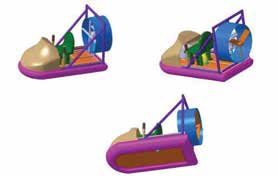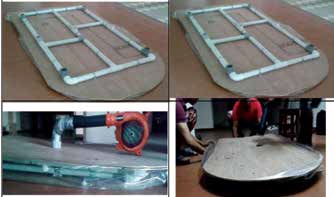Design & Construction of A Multiutility Air Cushion Vehicle
Introduction
• To design and build Hover craft more efficiently and to analyse the potential capabilities of designing and building hovercrafts
• To identify potential research areas related to hovercraft technology and implement upon completion of the project
• To introduce an energy-efficient way of travelling and search for other utilities of implementing this technology
• To make a cost effective & environment friendly Rescue vehicle to meet emergency situation in any sort of terrain
• To add more technological features especially for rescue oriented purposes.
 |
|
CATIA models of the product |
Stages of development |
Achievements
The stability of the hovercraft is increased. It shows that the air is getting distributed equally under the skirt.
There is lesser chance of capsizing. The hovercraft moves on the tile with very less effort. When tested on
tarmac, it is seen that lesser amount of force is required as compared to the above result. This shows that the
friction is significantly reduced as the physical contact between the skirt and the ground is reduced due to
increased pressure under the craft. This achieved by using the more powerful blower. The amount of air loss
under the skirt can be neglected. This is because the amount of air expelled under the craft is much greater than
that which escapes under the craft. This allows the craft to hover a few inches above the ground. The thrust
engine produce enough force to move the hovercraft forward. The blades are designed such a way that the pitch
angle is variable. This allows us to place the blades in the optimum angle to get maximum thrust.
For further information please contact
Amal Jyothi College of Engineering
Koovapally, Kanjirapally
Kottayam, Kerala 686518
Email : roshankuruvila@amaljyothi.ac.in








